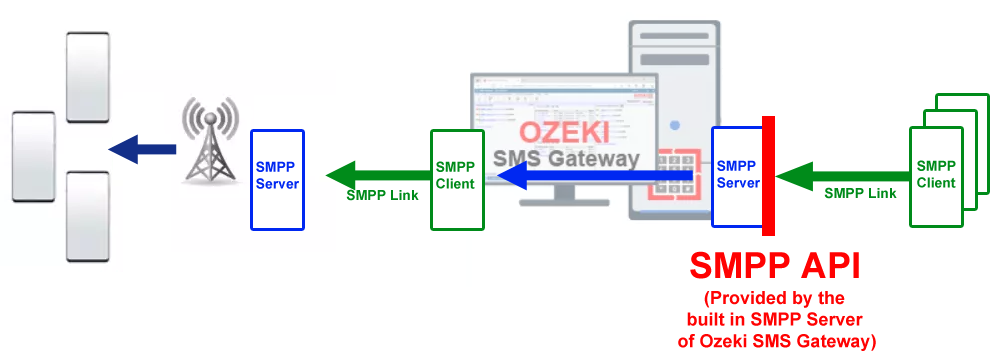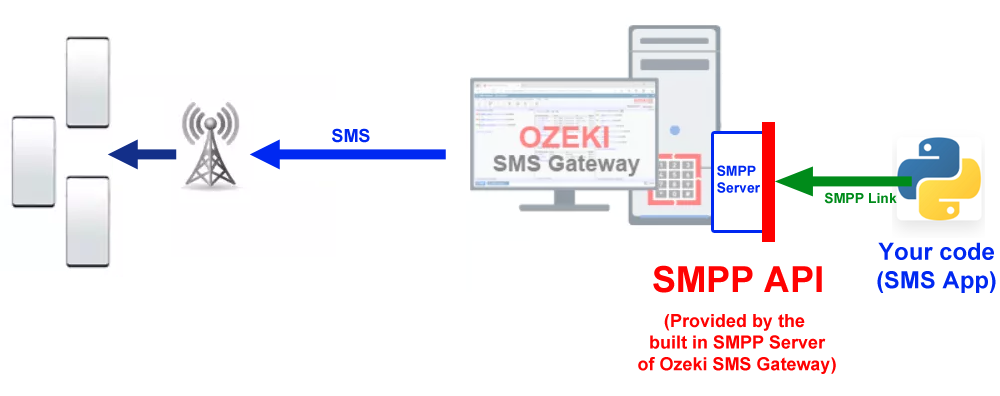SMPP API specifications, code examples, best practices
The Short Message Peer-to-Peer (SMPP) protocol is a cornerstone of modern SMS communication, enabling seamless messaging between applications and mobile networks. Ozeki SMS Gateway leverages the SMPP API to provide a robust platform for sending and receiving SMS, supporting versions 3.3, 3.4, and 5.0. This guide explores the SMPP protocol specifications, detailing their evolution, key features, and practical implementation using Ozeki SMS Gateway. From setting up SMPP API client and SMPP API server connections to ensuring GDPR compliance and optimizing performance, this comprehensive resource equips developers with the knowledge to harness the full potential of the SMPP API for reliable, secure, and efficient SMS communication.

SMPP API protocols
The Short Message Peer-to-Peer (SMPP) protocol facilitates SMS messaging between applications and mobile networks. Three key versions are in use: SMPP v3.3 (1997), which uses separate transmit and receive links; v3.4, introducing a more efficient transceiver model; and v5.0 (2003), featuring TLV fields but with limited adoption. Below is an overview of each specification.
SMPP v3.3 specification
There are three versions of the SMPP protocol specification in use. The original public version of the specification is SMPP v3.3 and was released in 1997. SMPP systems using this version usually rely on two links an SMPP transmitter and an SMPP receiver. One link is used for sending the other is used for receiving SMS.
Download: SMPP v3.3 PDF (373Kb)
SMPP v3.4 specification
The original specification was updated to SMPP v3.4, the most important change in this version was the recommendation to use a single TCP/IP link to send and receive SMS messages instead of two links. This is called the SMPP transceiver connection. The word transceiver is a mix of the words "transmitter" and "receiver". Using a single link makes connection management much easier and more resource efficient on the server side. This protocol version is the most widely used version to date (year %2025).
Download: SMPP v3.4.pdf (1.13Mb)
SMPP v5 specification
SMPP v5 is currently the most up to date version of the SMPP specification. This version was released in 2003. The major change in this version was the shift to using Type-Length-Value (TLV) fields. The idea was great, but this version is not as widely adapted as SMPP version 3.4, as most SMPP systems were in operation before this protocol version was released and few providers decided to upgrade their system to work according to this standard, as the previous standard is fulfilling most of the needs.
Download: SMPP v5.pdf (1.01Mb)
How to Setup and Configuration the SMPP API in Ozeki
To understand SMPP API connectivity, read the following articles. They offer insights on how to configure the SMPP API for seamless SMS delivery in Ozeki SMS Gateway. You will learn how to enable the SMPP API by turning on the SMPP Server connection and how to set up SMPP API clients. We have also written an article to help you in the process of choosing the best SMPP provider.

- How to Set Up an SMPP API Client connection with Your SMSC
- How to Set Up an SMPP API Server to to allos SMPP API client to Send and Receive SMS
- How to Choose the Right SMPP API Provider for Your Business
How to send SMS through the SMPP API
If you have enabled the SMPP API in Ozeki SMS Gateway by creating an SMPP user account, you can start to is for sending SMS (Short Message Peer-to-Peer) using native protocol implementations. In the following articles SMPP API examples are provided for various programming languages to help you get started. SMPP API examples are written for Python, JavaScript/Node.JS, Java, PHP, C#, and C++.

- How to Send SMS using the SMPP API at the protocol level
- How to Send SMS through the SMPP API using Python
- How to Send SMS through the SMPP API using Javascript/Node.JS
- How to Send SMS through the SMPP API using Java
- How to Send SMS through the SMPP API using PHP
- How to Send SMS through the SMPP API using C#
- How to Send SMS through the SMPP API using C++
How to receive SMS through the SMPP API
Receiving SMS via the SMPP API allows applications to process incoming messages in real time. This guide explains how to receive SMS at the protocol level, including setting up bindings and handling PDUs. Additionally, it covers retrieving delivery reports (DLRs) to track message status. Whether for notifications or two-way messaging, mastering these SMPP operations ensures reliable SMS communication.
- How to Receive SMS using the SMPP API at the protocol level
- How to Receive a Delivery report using the SMPP API at the protocol level
Security and Compliance
Securing and Optimizing Your SMPP API is crucial for reliability, compliance, and protection against abuse. The following guides cover security related questions through encryption and authentication, implementing rate limiting to prevent inbound abuse and outbound throttling errors, and binding restrictions to control client access. Additionally, it explores GDPR compliance for SMS messaging, ensuring data privacy and legal adherence. These best practices help maintain a robust, efficient, and compliant SMPP API integration.
- How to Secure Your SMPP API Connection Against Unauthorized Access
- How to Implement Rate Limiting with SMPP API to Prevent Abuse on incoming SMPP client connections
- How to Implement Rate Limiting with SMPP API to Prevent Throttling error on outgoing SMPP client connections
- How to Implement SMPP Binding limiting with SMPP API to Prevent Abuse
- How to Ensure GDPR Compliance When Using SMPP API for SMS
SMPP API Troubleshooting and Optimization
Troubleshooting and Optimization helps resolve SMPP API issues and enhance performance. Learn to diagnose common error codes and optimize throughput for high-volume SMS traffic. These guides ensure smooth, efficient messaging operations with minimal disruptions.
- How to Troubleshoot Common SMPP API Error Codes
- How to Optimize SMPP API Performance for High-Volume Messaging
- SMPP API Frequently Asked Questions
Summary
Mastering the SMPP API with Ozeki SMS Gateway empowers businesses and developers to build efficient, secure, and scalable SMS solutions tailored to diverse needs, from marketing campaigns to two-way messaging. By understanding the nuances of SMPP v3.3, v3.4, and v5.0, configuring robust client and server connections, and implementing best practices for security and GDPR compliance, users can harness the full potential of the SMPP API. The provided code examples in Python, Java, C#, and other languages, along with detailed troubleshooting and optimization strategies, ensure seamless integration and high-performance messaging.
